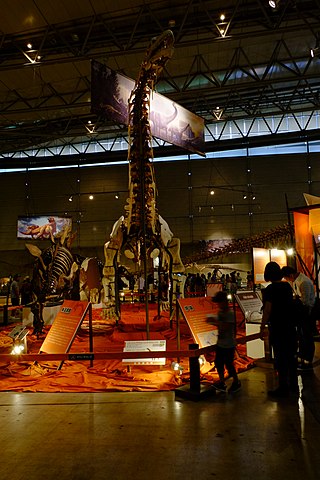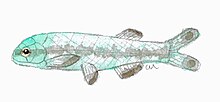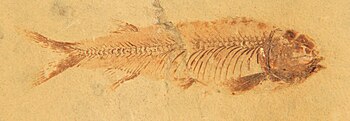The Yixian Formation is a geological formation in Jinzhou, Liaoning, People's Republic of China, that spans the late Barremian and early Aptian stages of the Early Cretaceous. It is known for its exquisitely preserved fossils, and is mainly composed of basalts interspersed with siliciclastic sediments.

Yanoconodon is a monotypic genus of extinct early mammal whose representative species Yanoconodon allini lived during the Mesozoic in what is now China. The holotype fossil of Yanoconodon was excavated in the Yan Mountains about 300 kilometres from Beijing in the Qiaotou member of the Huajiying Formation of Hebei Province, China, and is therefore of uncertain age. The Qiaotou Member may correlate with the more well-known Early Cretaceous Yixian Formation, and so probably dates to around 122 Ma ago.
Vescornis is a genus of enantiornithine bird. One species is named, V. hebeiensis. The holotype fossil is in the collection of the Nanjing Institute of Geology and Paleontology, Chinese Academy of Sciences. Its catalog number is CAGS 130722. The fossil was found in Early Cretaceous rocks first attributed to the Yixian Formation, Senjitu, Fengning County, Hebei Province, China. However, later study of area geology showed that these rocks actually belong to the Huajiying Formation.

The Jehol Biota includes all the living organisms – the ecosystem – of northeastern China between 133 and 120 million years ago. This is the Lower Cretaceous ecosystem which left fossils in the Yixian Formation and Jiufotang Formation. These deposits are composed of layers of tephra and sediment. It is also believed to have left fossils in the Sinuiju series of North Korea. The ecosystem in the Lower Cretaceous was dominated by wetlands and numerous lakes. Rainfall was seasonal, alternating between semiarid and mesic conditions. The climate was temperate. The Jehol ecosystem was interrupted periodically by ash eruptions from volcanoes to the west. The word "Jehol" is a historical transcription of the former Rehe Province.
The Jiufotang Formation is an Early Cretaceous geological formation in Chaoyang, Liaoning which has yielded fossils of feathered dinosaurs, primitive birds, pterosaurs, and other organisms. It is a member of the Jehol group. The exact age of the Jiufotang has been debated for years, with estimates ranging from the Late Jurassic to the Early Cretaceous. New uranium-lead dates reveal the formation is deposited in the Aptian stage of the Early Cretaceous. Fossils of Microraptor and Jeholornis are from the Jiufotang.

Protopteryx is an extinct bird and the most basal enantiornithean, from the Cretaceous period. The type species is P. fengningensis. It was first discovered in the Sichakou Member of the Yixian Formation or Huajiying Formation of Hebei Province, northern China, dating from 131 Ma ago. Protopteryx has been found in the Daibeigou formation, as well. The name Protopteryx means "primitive feather": "proto-" meaning "the first of" and "-pteryx" meaning "feather" or "wing." The name comes from the fact that Protopteryx feathers are more primitive than those of modern birds, such as the two elongated tail feathers that lack barbs and rami.
The Tuchengzi Formation is a geological formation in China whose strata span the Tithonian to Berriasian ages. Dinosaur fossils, particularly footprints, have been found from the formation.
Jibeinia is a genus of enantiornithean bird. Only one species has been named, Jibeinia luanhera. It is known from one holotype fossil found in the Hebei province, People's Republic of China. This fossil is now lost. The holotype was, however, described and figured in detail by Hou (1997).

The Yixian Formation is a geological formation in Jinzhou, Liaoning, People's Republic of China, that spans about 1.6 million years during the early Cretaceous period. It is known for its fossils, listed below.
The Sinuiju Formation(신의주층) is a geologic formation in North Korea. Formerly of uncertain age, it is now thought to be Early Cretaceous. A variety of fossils are known from the formation, including those of pterosaurs and birds, including an indeterminate anurognathid and a very large enantiornithine specimen with a 5 cm (2.0 in) long tibia and a 3.5 cm (1.4 in) long pygostyle. Frogs have also been found in the formation. Numerous compression fossils of insects have also been found.

Xianshanosaurus is a genus of sauropod dinosaur from the Early Cretaceous (Aptian-Albian) of the Ruyang Basin in Henan Province, China. Its type and only species is Xianshanosaurus shijiagouensis. It was described in 2009 by a team of paleontologists led by Lü Junchang. Xianshanosaurus may be a titanosaur, and Daxiatitan may be its closest relative, but its evolutionary relationships remain controversial.
The Haifanggou Formation, also known as the Jiulongshan Formation, is a fossil-bearing rock deposit located near Daohugou village of Ningcheng County, in Inner Mongolia, northeastern China.
The Huajiying Formation is a geological formation in Hebei, People's Republic of China. Known for its fossils including feathered dinosaurs, the age of the formation is uncertain. It may represent an early portion of the Jehol Biota, dating to somewhere in the early Cretaceous or late Jurassic periods. It may correlate with the early Cretaceous Dadianzi Formation and parts of the Yixian Formation, with an age range between 140 and 122 Ma ago. It contains the Qiaotou Member, sometimes treated as a distinct formation.
Shenqiornis is a bird genus of the Enantiornithes. It was found in the Qiaotou Member of the Huajiying Formation of Hebei Province, China, and is therefore of uncertain age. The Qiaotou Member may correlate with the more well-known Early Cretaceous Yixian Formation, and so probably is dated to the Aptian, around 122 million years ago.

Sinamia is an extinct genus of freshwater amiiform fish which existed in China, Japan, and possibly South Korea during the Early Cretaceous period. Like the related bowfin, it has an elongated low-running dorsal fin, though this was likely convergently evolved.

Anchiornithidae is a family of eumaniraptorans which could be the basalmost family of birds in the clade Avialae. Anchiornithids have been classified at varying positions in the maniraptoran tree, with some scientists classifying them as a distinct family, a basal subfamily of Troodontidae, members of Archaeopterygidae, or an assemblage of dinosaurs that are an evolutionary grade within Avialae or Paraves.
Fossiomanus is an extinct genus of tritylodontid mammaliamorphs from the Early Cretaceous of China. It includes one species, F. sinensis, which is known from a single nearly complete skeleton from the Aptian Jiufotang Formation. Features of its limbs and vertebrae indicate that Fossiomanus was adapted towards a fossorial lifestyle.

Brevirostruavis is a genus of Early Cretaceous enenatiornithine bird from the Early Cretaceous Jiufotang Formation of Liaoning, China. The type and only species is Brevirostruavis macrohyoideus.
Ruixinia is an extinct genus of somphospondylan titanosauriform dinosaur from the Early Cretaceous (Barremian) Yixian Formation of China. The genus contains a single species, Ruixinia zhangi. The Ruixinia holotype is a partial articulated skeleton with the most complete series of caudal vertebrae known from any Asian titanosauriform.














